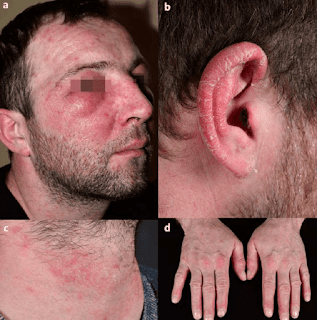CONTACT ALLERGIC DERMATITIS
Allergic contact dermatitis (ACD) is a form of contact dermatitis that is the manifestation of an allergic response caused by contact with a substance. The rash isn't contagious or life-threatening, but it can be very uncomfortable. Many substances can cause such reactions, including soaps, cosmetics, fragrances, jewelry and plants.
SYMPTOMS
Contact dermatitis usually occurs on areas of your body that have been directly exposed to the reaction-causing substance — for example, along a calf that brushed against poison ivy or under a watchband. The rash usually develops within minutes to hours of exposure and can last two to four weeks
Signs and symptoms of contact dermatitis include:
● A red rash
● Itching, which may be severe
● Dry, cracked, scaly skin
● Bumps and blisters, sometimes with oozing and crusting
● Swelling, burning or tenderness
When to see a doctor See your doctor if:
● The rash is so uncomfortable that you are losing sleep or are distracted from your daily activities
● The rash is sudden, painful, severe or widespread
● You're embarrassed by the way your skin looks
● The rash doesn't get better within three weeks
● The rash affects your face or genitals
CAUSES
Contact dermatitis is caused by a substance you're exposed to that irritates your skin or triggers an allergic reaction
Common irritants include: ● Solvents ● Rubbing alcohol ● Bleach and detergents ● Shampoos, permanent wave solutions ● Airborne substances, such as sawdust or wool dust ● Plants ● Fertilizers and pesticides
Common allergens include:
● Nickel, which is used in jewelry, buckles and many other items
● Medications, such as antibiotic creams and oral antihistamines
● Balsam of Peru, which is used in many products, such as perfumes, cosmetics, mouth rinses and flavorings
● Formaldehyde, which is in preservatives, disinfectants and clothing
● Personal care products, such as deodorants, body washes, hair dyes, cosmetics and nail polish
● Plants such as poison ivy and mango, which contain a highly allergenic substance called urushiol
● Airborne substances, such as ragweed pollen and spray insecticides
DIAGNOSIS
questioning you to uncover clues about the trigger substance, and examining your skin to note the pattern and intensity of your rash
PATCH TESTDuring a patch test, small amounts of potential allergens are applied to adhesive patches, which are then placed on your skin. The patches remain on your skin for two to three days, during which time you'll need to keep your back dry. Your doctor then checks for skin reactions under the patches and determines whether further testing is needed
TREATMENT
Steroid creams or ointments- A topical steroid may be applied one or two times a day for two to four weeks.
● Oral medications. In severe cases, your doctor may prescribe oral corticosteroids to reduce inflammation, antihistamines to relieve itching or antibiotics to fight a bacterial infection
PREVENTION
Avoid the irritant or allergen Apply an anti-itch cream or lotion to the affected area. A nonprescription cream containing at least 1 percent hydrocortisone can temporarily relieve your itch. A steroid ointment may be applied one or two times a day for two to four weeks. Or try calamine lotion
● Apply an anti-itch cream or lotion to the affected area. A nonprescription cream containing at least 1 percent hydrocortisone can temporarily relieve your itch. A steroid ointment may be applied one or two times a day for two to four weeks. Or try calamine lotion.
Take an oral anti-itch drug. A nonprescription oral corticosteroid or antihistamine, such as diphenhydramine (Benadryl), may be helpful if your itching is severe.
● Apply cool, wet compresses. Moisten soft washcloths and hold them against the rash to soothe your skin for 15 to 30 minutes. Repeat several times a day







Comments
Post a Comment